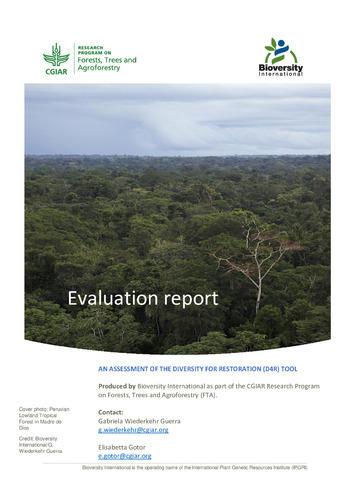Diversity for Restoration - D4R

The restoration of degraded land is a global concern. To improve the effectiveness of forest restoration action, D4R was developed to help in the appropriate choice of species and identify seed sources for a given project site that meet the desired restoration objectives. D4R also takes into account climate change when choosing appropriate material and includes information about the propagation of hundreds of tree species.
Thus, Diversity for Restoration is a tool developed to help with decision-making on the use of appropriate tree species and seed sources for tree-based restoration or other tree planting activities, originally designed for tropical dry forest in Colombia, but recently expanded to similar ecosystems in Peru, Ecuador and Burkina Faso and Cameroon.
D4R is a dynamic and scalable tool, both in terms of the inclusion of additional restoration objectives and the expansion to other countries. Among the new restoration objectives being rolled out are those related to nutrition and food security, and shade tree selection in cacao and coffee agroforestry systems. Application of the tool in other countries and ecosystems is underway in western Ethiopia, northern Thailand, the Sabah state of Malaysia and the Western Ghats in India, which will also allow the addition of context specific restoration objectives (e.g. conservation of sun bear, orangutan and hornbills in Sabah, Malaysia). While these are all forest ecosystems, the tool can be extended to other ecosystems as well. Furthermore, researchers plan to integrate an economic simulation module to provide users with additional information about which of the possible species combinations simultaneously maximize the benefit-cost ratio, considering a series of threats that may affect a restoration site over a given period of time.

Results are provided to the user as a report to be downloaded directly or received by email. The report is intended to serve as a guide for selecting appropriate species and seed sources for restoration of the specified site. Propagation protocols of individual species can be downloaded through hyperlinks. Recommended indicators for monitoring the success of restoration interventions are also included.
In what context is this tool useful?
Diversity for Restoration (D4R) is one such decision support tool aimed at all those interested in planting or regenerating trees, including scientists, restoration planners and practitioners as well as public authorities, investors and donors.
This tool helps in species selection and seed sourcing after restoration objectives and site conditions are determined. It is useful in a context where strengthening the seed selection decision-making process is necessary and increasing awareness is key, as it is the knowledge transfer and data management among key stakeholders.
Results
D4R was first piloted for the Colombian tropical dry forest, but recently expanded to similar ecosystems in Peru, Ecuador and Burkina Faso, and soon Cameroon. Users of the tool report it is strengthening the seed selection decision-making process and is increasing awareness, knowledge transfer and data management among key stakeholders.
The tool has good documentation and offers great potential in restoration. However, it is too new to have had a user evaluation. To date the platform has been primarily used in awareness raising and capacity building of integration of native tree diversity into restoration and has very warmly received by stakeholders. For example, the Minister of Environment Peru recently requested access to the tool and related publications. Results highlighted include how the tool increases the efficiency of the selection process since it can reduce costs and the time it usually takes to gather and process such information independently. It also provides informed and evidence-based results that can serve as a base on how and with what to start the restoration process, strengthening the activities on the ground. Most experts did not know of other tools similar to D4R. D4R was considered to encompass more information and addresses better the practical problems restoration practitioners face on the ground related to other tools. The tool is perceived by different stakeholders from restoration practitioners, NGOs, academia, public policy makers, development agencies etc. to complement restoration projects by strengthening capacity or knowledge of appropriately selecting planting material and by improving the decision-making process that is required to do an assessment to decide on which species to plant and where to obtain the seeds, that will be resilient to climate change.
Ultimately, the success of the D4R tool will be measured through its uptake by restoration planners. Researchers hope that the explanation of the mechanics behind the tool can contribute to this, as the recommendations of ‘black box’ approaches are less likely to be accepted by users.





